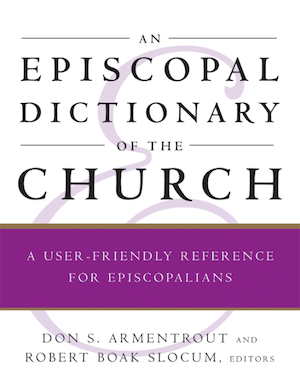Glossary of Terms
Central New York, Diocese of
The General Convention of 1868 voted to divide the Diocese of Western New York and create the Diocese of Central New York. Its primary convention met at Trinity Church, Utica, […]
Central Pennsylvania, Diocese of
1) The General Convention of 1904 voted to divide the Diocese of Central Pennsylvania. The primary convention of the Diocese of Harrisburg met at St. James Church, Lancaster, on Nov. […]
Central Philippines, Diocese of
The 1901 General Convention established the Missionary District of the Philippines. In 1973 the Diocese of the Philippines was divided into three missionary districts. One of these was the Central […]
Ceremonial
The physical actions, gestures, and postures of public worship. Ceremonial may be distinguished from ritual, which concerns the prescribed words that are used in worship. The BCP rubrics provide directions […]
Certain Trumpet, The
This journal was published at Norwalk, Connecticut, from Mar. 1972 until Feb. 1981. It was founded and edited by Perry Laukhuff, who wrote that “At Minneapolis [the 1976 General Convention], […]
Certificate of Membership
Any member of a congregation in the Episcopal Church is entitled to a certificate of membership to indicate whether the member is a communicant and to indicate whether the member […]
Chad, or Ceadda, Bishop of Lichfield
(d. Mar. 2, 672). He was one of Aidan's students at Lindisfarne. Around 665 he was consecrated Bishop of Mercia, and in Sept. 669 he moved the see to Lichfield. […]
Chalcedon, Council of
The fourth of the Ecumenical Councils, held in 451 at Chalcedon, a town near Constantinople. The council was held in the wake of the decision delivered by the so-called “Robber […]
Chalcedonian Definition
The Council of Chalcedon was summoned in 451 to consider the christological question in light of the “one-nature” picture of Christ proposed by Eutyches which prevailed at the “Robber Synod” […]
Chalice
The cup for the wine that is consecrated and administered at the eucharist. The chalice normally has a footed base. It is appropriate for only one chalice to be on […]
Chalice Bearer
See Lay Eucharistic Minister (LEM).
Chalice Veil
A square of material that covers the chalice and paten until they are needed for preparation of the altar at the eucharist. It typically matches the eucharistic vestments and the […]
Chancel
Area of the church set apart for the altar, lectern, pulpit, credence table, and seats for officiating and assisting ministers. It may also include the choir. The chancel is typically […]
Chancel Rail
Low railing or lattice-work that separates the chancel from the nave in a traditionally designed church. The term “chancel,” a liturgical space near the altar for clergy and choir, is […]
Chancellor
In the Episcopal Church a chancellor is a legal adviser appointed by the Presiding Bishop or a diocesan bishop. A chancellor advises the bishop and diocese on matters of secular […]
Chandler, Thomas Bradbury
(Apr. 26, 1726-Apr. 20, 1790). An Anglican parson in New Jersey and a Loyalist at a time when adherence to the Church of England and the British Crown were increasingly […]
Change Ringing
The ringing of tower bells of different tones in a precise relationship to each other in order to produce a pleasing cascade of sound. The sequence of bells is varied […]
Chant, Chanting
Singing liturgical prose texts to the rhythm of speech. The term is from the Latin cantus, “song.” Since ancient times, psalms and canticles, prayers, dialogue, scripture, and other liturgical texts […]
Chantry
An endowment or foundation for the saying of masses and prayers for the founder. It is also the place where the endowed masses are said. This may be a chapel […]
Chapel
A building or structure for worship that is not a church. Chapels may be found in public institutions, such as schools and hospitals. Chapels may also be found on private […]
Glossary definitions provided courtesy of Church Publishing Incorporated, New York, NY,(All Rights reserved) from “An Episcopal Dictionary of the Church, A User Friendly Reference for Episcopalians,” Don S. Armentrout and Robert Boak Slocum, editors.

